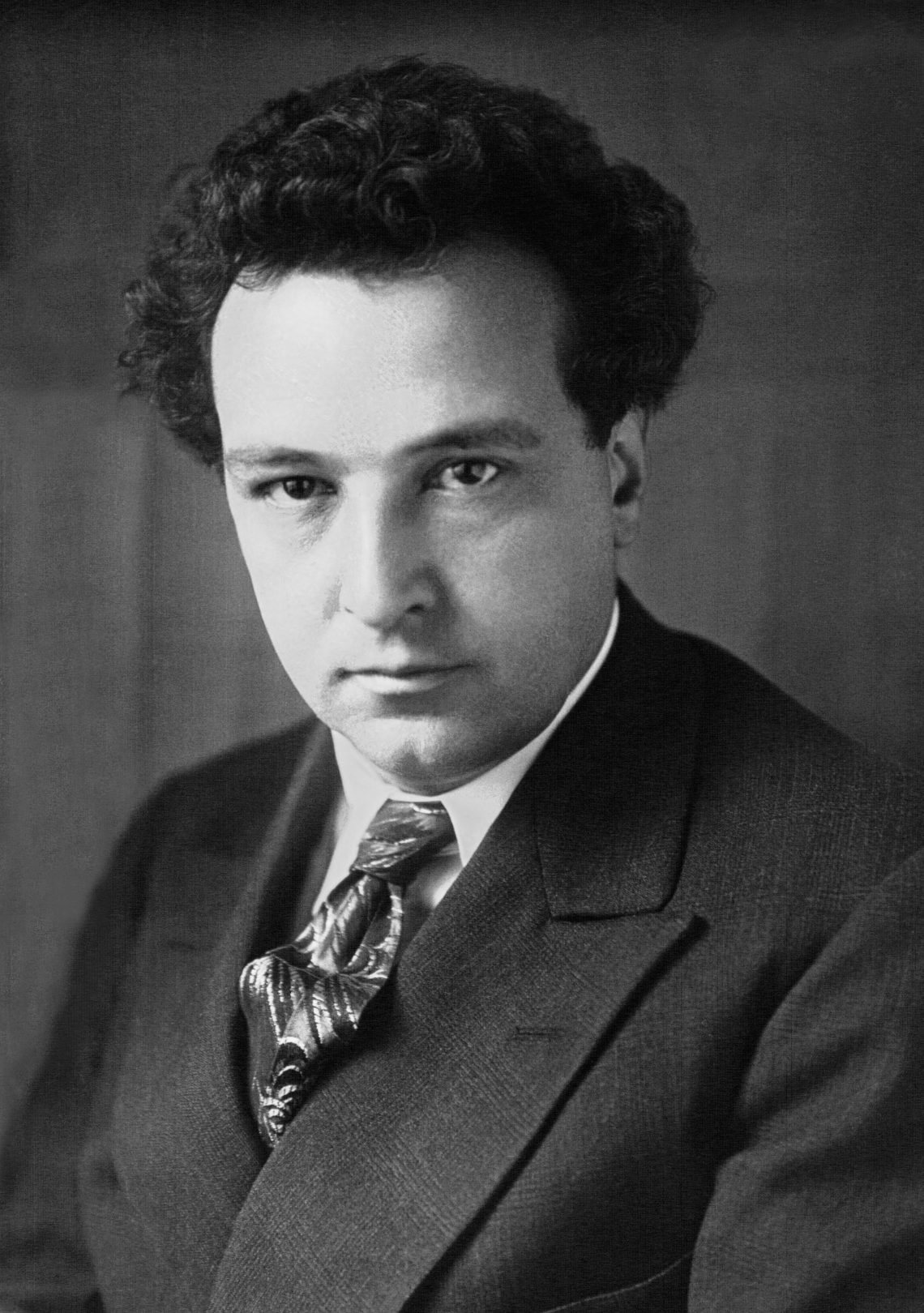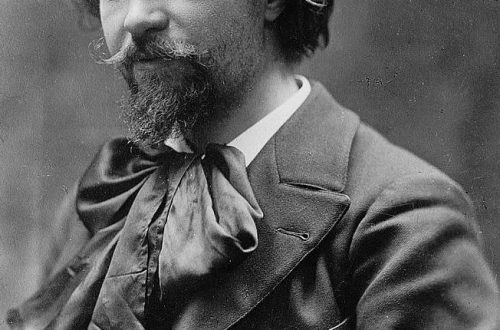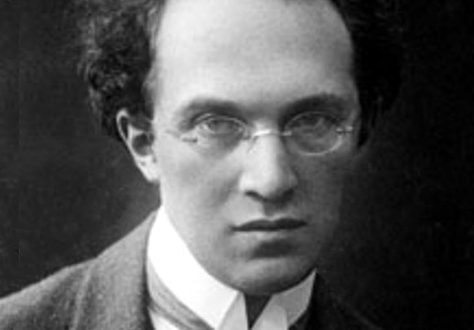
Arthur Honegger |
tirotiro
Arthur Honegger
He tohunga nui a Honegger, tetahi o nga kaitito waiata o enei ra e mohio ana ki te rangatira. E. Jourdan-Morange
Ko te kaitito waiata Wīwī a A. Honegger tētahi o ngā tohunga toi ahu whakamua o tēnei wā. Ko te oranga katoa o tenei kaiwaiata puoro me te tangata whakaaro he mahi ki tana toi aroha. I hoatu e ia ona pukenga me te kaha ki a ia mo te tata ki te 40 tau. Ko te timatanga o te mahi a te kaitito waiata no nga tau o te Pakanga Tuatahi o te Ao, i tuhia nga mahi whakamutunga i te tau 1952-53. Neke atu i te 150 nga tito tito a Peru Honegger, me te maha o nga tuhinga whakahirahira e pa ana ki nga momo take muramura o nga toi puoro o naianei.
He tangata no Le Havre, i noho a Honegger i te nuinga o tona tamarikitanga i Switzerland, te kainga tupu o ona matua. I ako ia i nga puoro mai i te tamarikitanga, engari kaore i te nahanaha, ahakoa i Zurich, i Le Havre ranei. Ma te kaha, ka timata ia ki te ako titonga i te 18 o ona tau i te Paris Conservatory me A. Gedalzh (te kaiako a M. Ravel). I konei, ka tutaki te kaitito waiata a muri ake nei ki a D. Milhaud, e ai ki a Honegger, he nui te awe ki runga i a ia, i whai waahi ki te hanga o ana reka me ana hiahia ki nga waiata hou.
He uaua te ara auaha o te kaitito. I te timatanga o te 20s. i uru ia ki te roopu auaha o nga kaiwaiata, e kiia ana e nga kaititiro ko te "French Six" (kia rite ki te maha o ona mema). Ko te noho a Honegger i roto i tenei hapori i tino kaha ki te whakaatu i nga taupatupatu whakaaro me nga mahi toi i roto i ana mahi. I whakanuia e ia te mahi hanga i roto i tana waiata puoro Pacific 231 (1923). Ko tana mahi tuatahi i haere tahi me te angitu nui, a, i puta te rongonui o te mahi i waenga i te hunga e aroha ana ki nga momo hua hou. "I tapaina tuatahitia e ahau te waahanga Symphonic Movement," ta Honegger te tuhi. “Engari… ka mutu taku whiwhinga, ka tapaina e au ko te Pacific 231. Koia te tohu o nga waka mamaoa e tika ana hei arahi i nga tereina taumaha”… Ka kitea ano te ngakau nui o Honegger mo te noho taone me te mahi hanga whare i etahi atu mahi o tenei wa: i te pikitia symphonic “ Rugby” me te “Symphonic Movement No. 3”.
Heoi, ahakoa nga hononga auaha me te "Ono", kua tohuhia te kaitito i nga wa katoa na te motuhake o te whakaaro toi, i te mutunga ka whakatauhia te rarangi matua o te whanaketanga o tana mahi. Kua i roto i te waenganui 20s. I timata a Honegger ki te hanga i ana mahi tino pai, he tino tangata, he manapori. Ko te tito rongonui ko te oratorio “Kingi Rawiri”. I whakatuwherahia e ia he mekameka roa o tana waiata puoro me te waiata puoro "Calls of the World", "Judith", "Antigone", "Joan of Arc i te tĭtĭ", "Dance of the Dead". I roto i enei mahi, ka huri takitahi a Honegger i nga ahuatanga o nga mahi toi o tona wa, e ngana ana ki te whakauru i nga whakaaro matatika teitei e mau tonu ana te uara mo te ao. No reira te tono ki nga kaupapa o mua, o te Paipera me te wharekarakia.
Ko nga mahi tino pai a Honegger kua hipa atu i nga waahanga nui rawa atu o te ao, ka mau i te hunga whakarongo ki te kanapa o te kare-a-roto me te hou o te reo puoro. Ko te kaitito waiata tonu i kaha ki te mahi hei kaikawe i ana mahi i roto i nga whenua maha i Uropi me Amerika. I te tau 1928 ka haere ia ki Leningrad. I konei, i whakaritea nga hononga whakahoahoa me te auaha i waenga i a Honegger me nga kaiwaiata Soviet, ina koa ki a D. Shostakovich.
I roto i ana mahi, ehara i te mea ko te titiro a Honegger mo nga kaupapa hou me nga momo momo, engari mo te hunga whakarongo hou. "Me whakarereke te puoro i te iwi whanui me te aro ki te tini," ka tohe te kaitito. "Engari mo tenei, me whakarereke e ia tana ahuatanga, kia ngawari, kia kore e uaua me nga momo momo nui. Kare te tangata e aro ki te tikanga kaitito me te rapu. Koinei te momo waiata i ngana ahau ki te tuku i roto i te "Jeanne at the stake". I ngana ahau ki te waatea ki te hunga whakarongo me te whakamere mo te kaiwaiata."
Ko nga wawata manapori o te kaitito waiata i kitea i roto i ana mahi i roto i nga momo puoro me nga momo tono. He maha ana tuhi mo te kiriata, reo irirangi, whare tapere whakaari. I te tau 1935 ka uru atu a Honegger, me etahi atu kaiwhakatangitangi haere whakamua, ki te roopu o te Popular Front anti-fascist. I roto i enei tau, i tuhia e ia nga waiata papatipu, i whakarereke i nga waiata a te iwi, i uru ki te whakarite waiata o nga mahi i roto i te ahua o nga huihuinga nui o te Huringa Nui o French. Ko te haere tonu o nga mahi a Honegger ko tana mahi i nga tau kino o te nohonga fascist ki Parani. He mema o te kaupapa whakatete, katahi ia ka hanga he maha o nga mahi o te tino kaupapa here whenua. Ko enei ko te Waiata Tuarua, Waiata Whakarewa me nga waiata mo te whakaaturanga reo irirangi Beats of the World. I te taha o te auaha o te reo me te oratorio, ko ana waiata waiata e 5 no nga tino whakatutukitanga o te kaitito waiata. Ko nga mea whakamutunga i tuhia i raro i te whakaaro tika o nga mahi kino o te pakanga. Ko te korero mo nga raru wera o to tatou wa, he mea nui ki te whanaketanga o te momo symphonic o te rau tau XNUMX.
I whakaatu a Honegger i tana mahi auaha ehara i te mea i roto i nga mahi toi puoro, engari i roto ano i nga mahi tuhituhi: e 3 nga pukapuka puoro me nga pukapuka kore korero i tuhia e ia. Na te maha o nga momo kaupapa i roto i nga taonga tuku iho a te kaitito waiata, ko nga raruraru o te waiata o naianei me ona hiranga hapori kei te waahi nui. I nga tau whakamutunga o tona oranga, i whakawhiwhia te kaitito waiata ki te ao katoa, he taote honore o te Whare Wananga o Zurich, a, he maha nga whakahaere puoro o te ao i arahi.
I. Vetlitsyna
Ngā tito:
opera – Judith (whakaari Paipera, 1925, 2nd ed., 1936), Antigone (lyric tragedy, lib. J. Cocteau after Sophocles, 1927, tr “De la Monnaie”, Brussels), Eaglet (L'aiglon , tahi me G. Iber, i runga i te whakaari a E. Rostand, 1935, i whakaturia i te tau 1937, Monte Carlo), paoro – He teka te pono (Vèritè – mensonge, puppet ballet, 1920, Paris), Skating-Ring (Skating-Rink, Swedish roller ballet, 1921, pou. 1922, Champs Elysees Theatre, Paris), Fantasy (Phantasie, ballet- sketch , 1922), I raro i te wai (Sous-marine, 1924, pou. 1925, Opera Comic, Paris), Metal Rose (Rose de mètal, 1928, Paris), Cupid and Psyche's Wedding (Les noces d 'Amour et Psychè, on the kaupapa o “French Suites” na Bach, 1930, Paris), Semiramide (ballet-melodrama, 1931, pou. 1933, Grand Opera, Paris), Icarus (1935, Paris), Kua Rere Te Manu Ma ( Un oiseau blanc s' est envolè, mo te hakari rererangi, 1937, Théâtre des Champs-Élysées, Paris), Waiata Waiata (Le cantique des cantiques, 1938, Grand Opera, Paris), Te Whanautanga o te Tae (La naissance des couleurs, 1940, ibid.), Te Karanga o nga Maunga (L'appel de la montagne, 1943, post. 1945, ibid.), Shota Rustaveli (me A. Tcherepnin, T. Harshanyi, 1945, Monte Carlo), Man in a Leopard Kiri (L'homme a la peau de lèopard, 1946); opereta – Ko nga Mahi a Kingi Pozol (Les aventures du roi Pausole, 1930, tr “Buff-Parisien”, Paris), Ataahua mai i Moudon (La belle de Moudon, 1931, tr “Jora”, Mézières), Baby Cardinal (Les petites Cardinal , me J. Hibert, 1937, Bouffe-Parisien, Paris); atamira oratorio – Kīngi Rawiri (Le roi David, i runga i te whakaari a R. Moraks, 1st putanga – Symphonic psalm, 1921, tr “Zhora”, Mezieres; 2nd edition – dramatic oratorio, 1923; 3rd edition – opera -oratorio, 1924, Paris ), Amphion (melodrama, 1929, post. 1931, Grand Opera, Paris), oratorio Cries of Peace (Cris du monde, 1931), oratorio Joan of Arc i te tĭtĭ (Jeanne d' Arc au bucher, tuhinga na P. Claudel, 1935, Spanish 1938, Basel), oratorio Dance of the Dead (La danse des morts, tuhinga na Claudel, 1938), pakiwaitara whakaari Nicolas de Flue (1939, pou. 1941, Neuchâtel ), Christmas Cantata (Une cantate de Noel , in liturgical and folk texts, 1953); mo te orchestra – 5 waiata waiata (tuatahi, 1930; tuarua, 1941; Liturgical, Liturgique, 1946; Basel pleasures, Deliciae Basilienses, 1946, symphony of three res, Di tre re, 1950), Prelude to the drama “Aglavena and Selinette (” pour ” Aglavaine et Sèlysette”, 1917), Te Waiata a Nigamon (Le chant de Nigamon, 1917), Te Poutohu o nga Taakaro o te Ao (Le dit des jeux du monde, 1918), Suite Summer Pastoral (Pastorale d'ètè , 1920), Mimic Symphony Horace- toa (Horace victorieux, 1921), Waiata o te hari (Chant de joie, 1923), Prelude to Shakespeare's The Tempest (Prèlude pour “La tempete”, 1923), Pacific 231 (Pacific 231, 1923). ), Whutuporo (Whutuporo, 1928) , Symphonic movement No 3 (Mouvement symphonique No3, 1933), Suite mai i te waiata mo te kiriata “Les Misérables” (“Les misèrables”, 1934), Nocturne (1936), Serenade Angélique (Sèrènade ringihia Angèlique, 1945), Suite archaique (Suite archaique, 1951), Monopartita (Monopartita, 1951); konohete me te orchestra – concertino mo te piana (1924), mo Volch. (1929), chamber concerto mo te putorino, Ingarihi. haona me nga aho. orc. (1948); ensembles taputapu ruma — 2 sonata mo Skr. me te fp. (1918, 1919), sonata mo te viola me te piana. (1920), sonata mo vlc. me te fp. (1920), sonatina mo te 2 Skr. (1920), sonatina mo te clarinet me te piana. (1922), sonatina mo Skr. me VC. (1932), 3 aho. quartet (1917, 1935, 1937), Rhapsody for 2 putorino, clarinet and piano. (1917), Anthem for 10 strings (1920), 3 counterpoints for piccolo, oboe, skr. me VC. (1922), Prelude and Blues mo te harp quartet (1925); mo te piana – Scherzo, Humoresque, Adagio expressivo (1910), Toccata and Variations (1916), 3 wahi (Prelude, Dedication to Ravel, Hommage a Ravel, Dance, 1919), 7 wahi (1920), Sarabande mai i te album “Six” ( 1920), Swiss Notebook (Cahier Romand, 1923), Dedication to Roussel (Hommage a A. Rousell, 1928), Suite (mo te 2 fp., 1928), Prelude, arioso and fughetta on a BACH theme (1932), Partita ( mo 2 fp., 1940), 2 huahua (1943), Maumaharatanga mo Chopin (Souvenir de Chopm, 1947); mo te violin takitahi — sonata (1940); mo te okana – fugue and chorale (1917), mo te putorino – Kanikani o te koati (Danse de la chevre, 1919); romances me waiata, tae atu ki te G. Apollinaire, P. Verlaine, F. Jammes, J. Cocteau, P. Claudel, J. Laforgue, R. Ronsard, A. Fontaine, A. Chobanian, P. Faure me etahi atu; waiata mo nga mahi whakaari whakaari – The Legend of the Games of the World (P. Meralya, 1918), Dance of Death (C. Larronda, 1919), Newlyweds on the Eiffel Tower (Cocteau, 1921), Saul (A. Zhida, 1922), Antigone ( Sophocles – Cocteau, 1922), Lilyuli (R. Rolland, 1923), Phaedra (G. D'Annunzio, 1926), Hūrae 14 (R. Rolland; me etahi atu kaitito, 1936), Silk slipper (Claudel, 1943), Karl the Bold (R Morax, 1944), Prometheus (Aeschylus - A. Bonnard, 1944), Hamlet (Shakespeare - Gide, 1946), Oedipus (Sophocles - A. Both, 1947), State of Siege (A. Camus, 1948) ), Ma te aroha kaua e whakakatakata (A. Musset, 1951), Oedipus the King (Sophocles – T. Molniera, 1952); waiata mo te reo irirangi – 12 whiu i waenganui po (Les 12 coups de minuit, C. Larronda, radiomystery for choir and orc., 1933), Radio panorama (1935), Christopher Columbus (V. Age, radio oratorio, 1940), Beatings of the world ( Battements du monde, Age, 1944), Te Upoko koura (Tete d'or, Claudel, 1948), St. Francis of Assisi (Age, 1949), Te Taraehara o François Villon (J. Bruire, 1951); waiata mo nga kiriata (35), mai te “Crime and Punishment” (mai ia FM Dostoevsky), “Les Misérables” (mai ia V. Hugo), “Pygmalion” (mai ia B. Shaw), “Abduction” (mai ia Sh. F. Ramyu), "Kapene Fracas" (e ai ki a T. Gauthier), "Napoleon", "Rere i runga i te Atlantic".
Nga mahi tuhituhi: Incantation aux fossiles, Lausanne (1948); Je suis compositeur, (P., 1951) (Rusia translation – He kaitito ahau, L., 1963); Nachklang. Schriften, Whakaahua. Tuhinga, Z., (1957).
Tohutoro: Shneerson GM, waiata Wīwī o te rautau XX, M., 1964, 1970; Yarustovsky B., Symphony about war and peace, M., 1966; Rappoport L., Arthur Honegger, L., 1967; her, Some Features of A. Honegger's Harmony, in Sat: Problems of Mode, M., 1972; Drumeva K., Dramatic oratorio by A. Honegger “Joan of Arc at the stake”, in collection: From the history of foreign music, M., 1971; Sysoeva E., Ko etahi patai mo te symphonism a A. Honegger, i te kohinga: No te hitori o nga waiata o tawahi, M., 1971; tana ake, A. Onegger's Symphonies, M., 1975; Pavchinsky S, Nga mahi Symphonic a A. Onegger, M., 1972; George A., A. Honegger, P., 1926; Gerard C, A. Honegger, (Brux., 1945); Bruyr J., Honegger et son oeuvre, P., (1947); Delannoy M., Honegger, P., (1953); Tappolet W., A. Honegger, Z., (1954), id. (Neucntel, 1957); Jourdan-Morhange H., Mes amis musiciens, P., 1955 Guilbert J., A. Honegger, P., (1966); Dumesnil R., Histoire de la musicique, t. 1959- La première moitiè du XX-e sícle, P., 5 (Rusia whakamaoritanga o nga kongakonga - Dumesnil R., Nga kaitito French hou o te roopu ono, ed. me te tuhinga whakauru M. Druskina, L., 1960) ; Peschotte J., A. Honegger. L'homme et son oeuvre, P., 1964.





